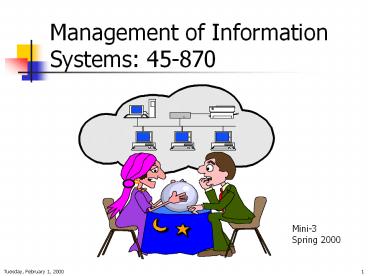Management of Information Systems: 45-870 - PowerPoint PPT Presentation
Title:
Management of Information Systems: 45-870
Description:
Management of Information Systems: 45870 – PowerPoint PPT presentation
Number of Views:12
Avg rating:3.0/5.0
Title: Management of Information Systems: 45-870
1
Management of Information Systems 45-870
Mini-3 Spring 2000
2
Agenda
- Announcements
- Technology Byte Presentations
- Designing and Creating Databases (Contd)
- Brief Review of Database Design Principles
- Using MS Access 2000 to Create Relational
Databases - Writing Queries for Relational Databases
- Using MS Access 2000 to Write Queries for
Relational Databases
3
Announcements
- Technology Byte Presentations
- Today (2/1)
- Section A DeathSpiral.Com, E-Sixpack
- Section B Jerees Kids, Hot TaMaLes
- Thursday (2/3)
- Section A Digital Agents, Hyperlinks
- Section B Alwin the Chipmunks, Cash Money
Brothers - IT Exercise I Graded/Returned
- Comments
4
Announcements
- Schedule modifications
- There will be NO handout on Internet, Intranets,
Extranets - Today we will continue with Database topics
- We will discuss Chapter 6 on Thursday (2/3)
- IT Exercise II due no later than midnight this
Friday, 2/4/00 - Submit one set of answers for your team
- You can email to me as an MS Word attachment or
submit as hard copy
5
Announcements
- Technology Byte Report
- Due on no later than midnight this Friday, 2/4/00
- Submit as a web page linked to your teams home
page that you had created in the first IT exercise
6
Technology Byte Presentations
- Section A
- DeathSpiral.Com
- E-Sixpack
- Section B
- Jerees Kids
- Hot TaMaLes
7
Creating Relational DatabasesBrief Review
- What is a relational database
- Going from a flat file to a relational
database..
8
A Traditional Flat File
9
Relational DataBase
Faculty Table
Dept Table
Course Table
10
How to get from a flat file to a relational
database?
- Identify Entities (Tables)
- Identify Attributes (Fields)
- Normalize Entities
- Identify Relationships between Normalized
Entities - Identify Primary and Foreign Keys
11
EXAMPLE 1 Department DB
- Data include
- Department Name
- Department Chair
- Department Address
- Department Phone
- Faculty ID
- Faculty Name
- Faculty Rank
- Course Name
- Course
- Course Credits
- Course Enrollment Capacity
12
Step1 Pull out repeating groups (First Normal
Form)
FROM Department (Dept-Name, Dept-Chair,
Dept-Addr, Dept-Phone, Fac-ID, Fac-Name,
Fac-Rank, Course-Name, Course, Course-Cred,
Course-Cap) TO Department (Dept-Name,
Dept-Chair, Dept-Addr, Dept-Phone) Faculty-Cour
se (Fac-ID, Fac-Name, Fac-Rank,
Course-Name, Course, Course-Cred, Course-Cap)
13
Step2 Pull out facts about a portion of the
key (Second Normal Form)
Doesnt apply here?
14
Step3 Pull out facts about a non-key
attribute (Third Normal Form)
FROM Faculty-Course (Fac-ID, Fac-Name, Fac-Rank,
Course-Name, Course, Course-Cred,
Course-Cap) TO Faculty (Fac-ID, Fac-Name,
Fac-Rank) Course (Course-Name, Course,
Course-Cred, Course-Cap)
15
Normalized Relations for this Data
Department (Dept-Name, Dept-Chair, Dept-Addr,
Dept-Phone) Faculty (Fac-ID, Fac-Name, Fac-Rank,
Fac-Dept) Course (Course-Name, Course,
Course-Cred, Course-Cap, Course-Fac)
16
From Normalized Relations to an Entity
Relationship Diagram
- each normalized relation becomes an entity
- identifier of each normalized relation becomes
the primary key - secondary identifier of each normalized relation
becomes a foreign key - Characteristics of each normalized relation
determine relationship between entities
17
Entity Relationship Diagram Example 1
(Dept-Name, Dept-Chair, Dept-Addr, Dept-Phone)
Department
Faculty
(Course, Course-Name, Course-Cred, Course-Cap, C
ourse-Fac)
Course
(Fac-ID, Fac-Name, Fac-Rank, Fac-Dept)
18
From an ERD to a Database in MS Access 2000
- Adding Tables, Relationships and Data
- By hand
- Importing from spreadsheet
- Important!
- Must use normalized tables, relationships and
data when creating the database in MS Access - Illustration for Example 1
- See Data for IT Exercise II and MS Access Tips 1
19
Retrieving Data from Databases
- Selecting Relations
- Joining Relations
- Projecting columns (fields) from the joined
relation - Selecting rows (records) from the joined relation
20
Retrieving Data from Databases (Contd)
- Deriving new attributes
- Indexing/sorting rows (records)
- Calculating totals
- Presenting data
21
Writing Queries in MS Access 2000
- See MS Access Tips 2
- Simple queries
- Grouping, summing sorting fields
- Selecting data
- Calculated fields
- Displaying/not displaying fields
- Make vs. Select Table queries
- Illustrative Examples
22
Designing DatabasesAnother Example
- Normalizing and creating an ERD for the Sales
Report Data
23
EXAMPLE 2 Sales Report Data
- Data includes
- Sales Person
- Sales Person Name
- Sales Area
- Customer Name
- Customer Number
- Warehouse Number
- Warehouse Location
- Sales Amount
24
Step1 Pull out repeating groups (First Normal
Form)
FROM SalesReport (SalesPerson,
SalesPerson-Name, Sales-Area, Customer,
Customer-Name, Warehouse, Warehouse-Location,
Sales-Amount) TO SalesPerson (SalesPerson,
SalesPerson-Name, Sales-Area) SalesPerson-Custom
er (SalesPerson, Customer,
Customer-Name, Warehouse,
Warehouse-Location, Sales-Amount)
25
Step2 Pull out facts about a portion of the
key (Second Normal Form)
FROM SalesPerson-Customer (SalesPerson,
Customer, Customer-Name, Warehouse,
Warehouse-Location, Sales-Amount) TO Sales
(SalesPerson, Customer, Sales-Amount) Customer-
Warehouse (Customer, Customer-Name,
Warehouse, Warehouse-Location)
26
Step3 Pull out facts about a non-key
attribute (Third Normal Form)
FROM Customer-Warehouse (Customer,
Customer-Name, Warehouse,
Warehouse-Location) TO Customer (Customer,
Customer-Name) Warehouse (Warehouse,
Warehouse-Location)
27
Normalized Relations for this Data
Sales (SalesPerson, Customer,
Sales-Amount) SalesPerson (SalesPerson,
SalesPerson-Name, Sales-Area) Customer
(Customer, Customer-Name, Warehouse) Warehouse
(Warehouse, Warehouse-Location)
28
Entity Relationship Diagram Example
(SalesPerson, SalesPerson-Name, Sales-Area)
SalesPerson
Sales
(Customer, Customer-Name, Warehouse)
Customer
(SalesPerson, Customer, Sales-Amount)
Warehouse
(Warehouse, Warehouse-Location)































